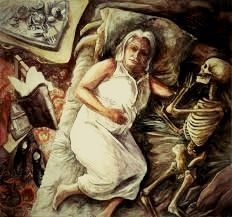A "Battle Royal" Fight for Civil Rights
A "Battle Royal" Fight for Civil Rights
 |
| Ralph Ellison |
to make things right. The early twentieth century was a time of social change and, for some, significant prosperity. Unfortunately, for most African Americans, their roles did not alter much from their experiences throughout the 1800s, when their civil rights were non-existent, and racism was rooted in every facet of America. Born in 1914, Ralph Ellison separated himself as a notable African American author and was renowned nationwide. He wrote the National Book Award winner, Invisible Man, in 1953, which included the famous first chapter, “Battle Royal,” where an unidentified man participates in a free-for-all blind boxing match where young black men are paid to fight each other for the viewing pleasure of the white men that surround the ring. Throughout his story, Ellison’s portrayal of various forms of racism, accompanied by the lack of African American Literary Tradition, represents early twentieth-century race relations.
The twentieth century might have been filled with change, but it did not begin that way. African Americans’ lives changed in various ways as far as civil rights are concerned. When Plessy v. Ferguson was decided in 1896, the Supreme Court allowed for the distribution of separate facilities and services to blacks and whites as long as the facilities and services were equal. These laws paved the way for new laws to be implemented, such as the Jim Crow Laws, which created legally segregated schools, transportation systems, restrooms, and living spaces. Unfortunately, this directly affected African American schooling as they did not get the proper funding to keep up with the all-white schools that were getting a much better education in much safer and cleaner conditions. As writing and journalism became more popular, it opened the door for writers like Ralph Ellison to leave his mark on the African American Literary Tradition. Overall, the beginning of the twentieth century displayed many forms of racism and set the stage for reform as the century progressed. Historians and prominent politicians alike cannot look past times like these, which will forever loom in the back of American’s minds.
 |
| Ralph Ellison's novel Invisible Man |
Racism, also a very prominent topic in Ellison’s work, was deeply rooted in the twentieth century as blacks tried to fight for their equality. In "The Battle Royal," Ellison masterfully captures the essence of racial oppression through the protagonist's experience. The narrator describes the environment as they were sent to the “front of the ballroom, where it smelled even more strongly of tobacco and whiskey” (Ellison 337), further signaling the lesser environment that the black men were forced into for the white men’s enjoyment. Furthermore, Norman German’s interpretation of the story helps the reader visualize the setting when saying, “...the boxing ring symbolizes the blacks being socially confined” (German 396). As various historians and readers continue to give their interpretations of the story, America’s longstanding history will continue to back it up.
 |
| Booker T. Washington |
they helped to keep the order within the negro communities” (Kostelanetz 6). This is important to note because Ellison goes as far as to have the story's narrator say, “In those pre-invisible days I visualized myself as a potential Booker T. Washington” (Ellison 336), which demonstrates the meaning of Washington to the black community as a means of representation. Washington stood for opportunity on the end of the African Americans. He was not someone who outwardly protested or fought for equality but instead believed that if black Americans had an opportunity to be successful, they could make the most of it. This led to the development and implementation of the Tuskegee Institute in 1881 to train teachers in Alabama. Ultimately, this connects back to the narrator’s slip-up in the story when he says “social equality” and not the scripted “social responsibility” as written in his speech. In Washington’s eyes, “...if the Negro were to succeed, he must not challenge the system of white supremacy. In Washington’s pet phrase, he must campaign for ‘responsibility,’ not ‘equity.’” (Kostelanetz 7). All the more reason to draw comparisons between the two, but it is notable to understand that Booker T. Washington was not like many other African Americans who fought for justice and peace in southern America, making him a fascinating figure for Ellison to advert to in his story.
To summarize, the early twentieth century was a pivotal time for America. The fight for civil rights continued as racism plagued white America. With the help of African American writers such as Ralph Ellison, various perspectives and light were shown on the atrocities that filled the nation. In connection with his work, the lack of African American Literary Tradition and the reference to different ways racism can be apparent helps him develop critical themes in “The Battle Royal.”
Works Cited
Ellison, Ralph. “The Battle Royal.” The Invisible Man, edited by Lois Tyson, Taylor & Francis, 2020, p. 335–346.
Hoberek, Andrew. “Race Man, Organization Man, Invisible Man.” Blooms Modern Critical Views: Ralph Ellison–New Edition, edited by Harold Bloom, Infobase Publishing, 2010, p. 29–47.
Invisible Man. National Book Foundation, www.nationalbook.org/books/invisible-man/. Accessed 18 Mar. 2024.
Kostelanetz, Richard. “The Politics of Ellison’s Booker: ‘Invisible Man’ as Symbolic History.” Chicago Review, vol. 19, no. 2, 1967, pp. 5–26. JSTOR, https://doi.org/10.2307/25294090. Accessed 16 Mar. 2024.
Ralph Ellison. Black Past, www.blackpast.org/african-american-history/ellison-ralph-1913-1994/. Accessed 18 Mar. 2024.
Tyson, Lois. Using Critical Theory. Available from: VitalSource Bookshelf, (3rd Edition). Taylor & Francis, 2020.


Comments
Post a Comment